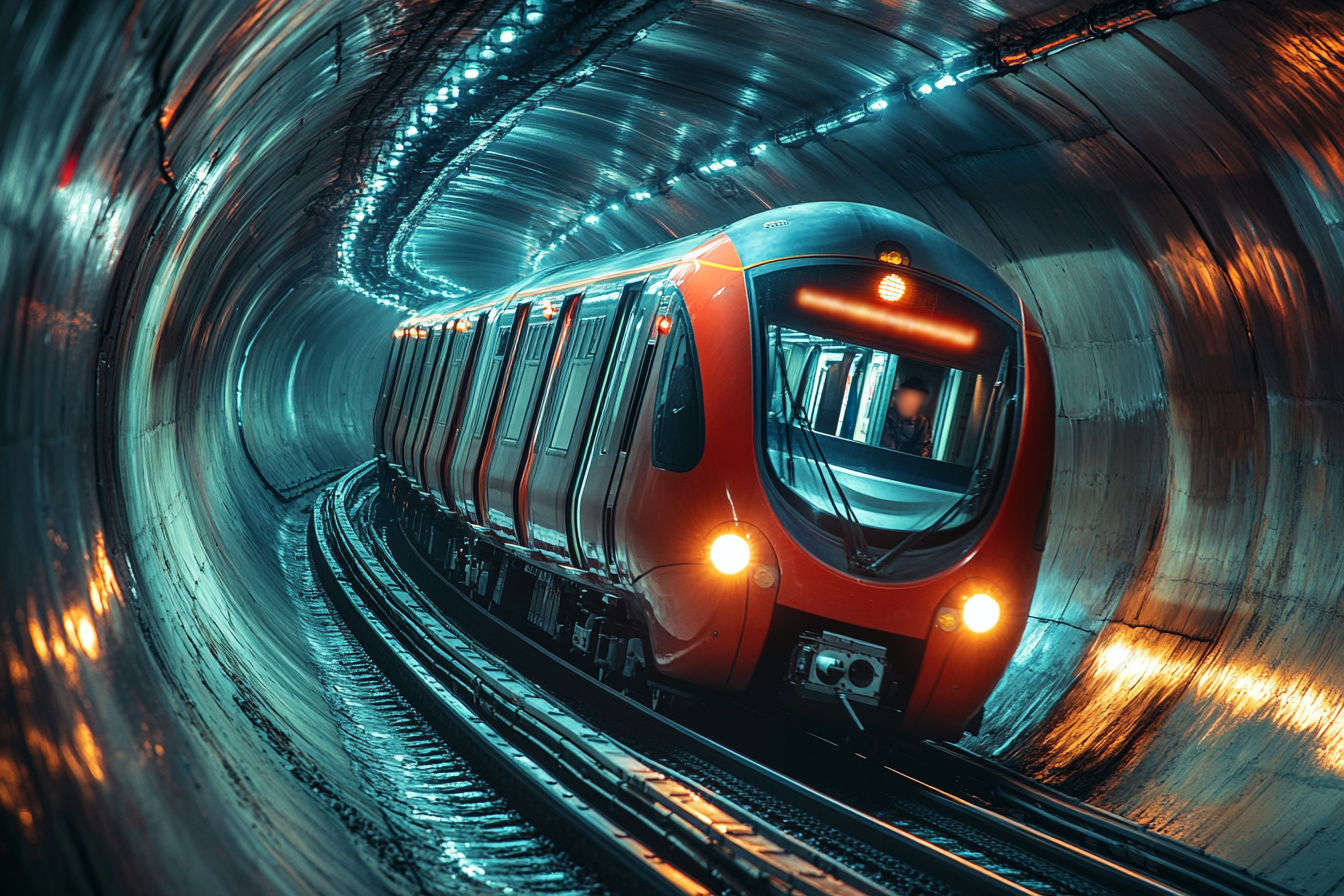Tottenham Court Road Tube Guide: Which Lines to Take? The Definitive Londoner’s Handbook
Master Tottenham Court Road station with our definitive guide. Discover how to use the Central, Northern, and Elizabeth lines to explore London with ease.

This post may contain affiliate links. If you make a purchase through these links, we may earn a commission at no additional cost to you.
Step out into the electric fizz of London’s West End, and you’ll find yourself at a crossroads of culture, commerce, and history. At the heart of it all stands Tottenham Court Road station—not just a stop on the Tube map, but a sprawling, state-of-the-art gateway to the city. Once a slightly scruffy and confusing interchange, it has been reborn as a gleaming, modern hub, connecting three of London’s most vital arteries: the venerable Central and Northern lines and the game-changing Elizabeth line.
For tourists, it’s the gateway to the British Museum and the shoppers’ paradise of Oxford Street. For Londoners, it’s a crucial interchange for commuting, socialising, and exploring. But navigating its depths can feel like a mission. Which line goes where? How do you find the right platform? And what’s the quickest way to get from A to B?
Fear not. This is your ultimate guide. We’ll break down everything you need to know, from which line to take for your destination to the station’s fascinating history and its dazzling art. Think of it as your personal handbook to mastering one of London’s most important and impressive transport hubs. Whether you’re a first-time visitor or a seasoned local, you’re about to become an expert on Tottenham Court Road.
First Things First: Where Exactly Is Tottenham Court Road Station?
Before we dive into the lines, let’s get our bearings. Tottenham Court Road station sits at St Giles Circus, a bustling intersection where several famous London roads meet:
- Oxford Street (to the west), Europe’s busiest shopping street.
- New Oxford Street (to the east), its continuation towards Holborn.
- Tottenham Court Road (to the north), famous for its electronics and furniture shops.
- Charing Cross Road (to the south), a haven for book lovers.
This prime location puts you within a short stroll of Soho, Covent Garden, Bloomsbury, and Fitzrovia. The station has multiple entrances, but the main ones are on the corner of Oxford Street and Charing Cross Road, with a large, modern plaza that makes it easy to spot.
The Three Titans: Which Line Do You Need?
Tottenham Court Road is served by three powerhouse lines. Each one carves a distinct path through London, so picking the right one is key. Let’s break them down.
1. The Central Line: The Speedy Red Artery
In a Nutshell: The Central line is the east-west workhorse of the London Underground. It’s fast, frequent, and plunges deep underground, connecting the suburbs of Essex and West London with the city’s core.
If you’re standing on the platform, you’ll see two directions: Westbound and Eastbound.
Taking the Central Line Westbound?
A westbound Central line train will take you towards London’s famous shopping and entertainment districts, as well as major transport hubs.
Key Westbound Stops from Tottenham Court Road:
- Oxford Circus (1 min): The absolute heart of London’s shopping world. Change here for the Bakerloo and Victoria lines. It’s the quickest way to get to Regent Street and Carnaby Street.
- Bond Street (3 mins): More high-end shopping on Oxford Street and, of course, Bond Street itself. You can also change here for the Jubilee line and the Elizabeth line.
- Marble Arch (5 mins): The western end of Oxford Street, right next to Hyde Park. Perfect for a stroll in the park or a visit to Speaker’s Corner.
- Notting Hill Gate (10 mins): Your stop for the world-famous Portobello Road Market and the colourful houses of Notting Hill. Change here for the Circle and District lines.
- Shepherd’s Bush (15 mins): Home to the vast Westfield London shopping centre. Also connects to London Overground services.
- Ealing Broadway (25 mins): A major hub in West London, with connections to National Rail services towards Heathrow and Reading.
Pro Tip: The Central line gets incredibly busy during peak hours, especially the section between Oxford Circus and Holborn. Be prepared for a squeeze! It’s also one of the deepest and warmest lines on the network, so it can get a bit stuffy in summer.
Taking the Central Line Eastbound?
Heading east will whisk you away from the West End’s glamour and into the financial heart of the City of London, the trendy East End, and out towards Essex.
Key Eastbound Stops from Tottenham Court Road:
- Holborn (2 mins): Just one stop away, this is a useful interchange for the Piccadilly line, which serves Heathrow Airport and the museum district of South Kensington.
- Chancery Lane (4 mins): Alight here for London’s legal district, including the Royal Courts of Justice.
- St. Paul’s (6 mins): Drops you right at the foot of the magnificent St. Paul’s Cathedral.
- Bank (8 mins): The epicentre of London’s financial district, the “Square Mile.” It’s a massive interchange where you can connect to the Northern, Waterloo & City, and DLR (Docklands Light Railway) lines.
- Liverpool Street (10 mins): A huge station connecting to National Rail services for Stansted Airport and East Anglia. It’s also your gateway to the vibrant areas of Shoreditch and Spitalfields. Change here for the Circle, Hammersmith & City, Metropolitan, and Elizabeth lines.
- Stratford (20 mins): The home of the Queen Elizabeth Olympic Park and another huge Westfield shopping centre. A major East London hub with connections to the Jubilee, DLR, Overground, and National Rail.
When to Choose the Central Line:
- You want to travel quickly across the centre of London from east to west.
- You’re heading to major shopping areas like Oxford Street or Westfield.
- You need to connect to the financial district at Bank or Liverpool Street.
2. The Northern Line: The North-South Spine
In a Nutshell: The Northern line is one of the most complex but useful lines on the network. It splits into two different branches in both the north and the south, so paying attention to the train’s final destination is crucial. It’s the black line on the map, and it connects the northern heights of London with the south.
At Tottenham Court Road, you’re on the Charing Cross branch.
Taking the Northern Line Northbound?
A northbound Northern line train from Tottenham Court Road will take you towards some of London’s most beloved neighbourhoods and major railway stations.
Key Northbound Stops from Tottenham Court Road:
- Goodge Street (1 min): A quiet stop in Fitzrovia, great for media companies and cosy pubs.
- Warren Street (3 mins): Useful for University College London (UCL) and University College Hospital (UCH). Change here for the Victoria line.
- Euston (5 mins): A major National Rail terminus for trains to the Midlands, the North West (including Manchester and Liverpool), and Scotland. You can also change for the Victoria line and London Overground.
- Camden Town (9 mins): The legendary home of punk music, alternative culture, and sprawling markets. This is where the Northern line splits. You’ll need to decide if you want the High Barnet or Edgware branch.
- High Barnet branch: Takes you to leafy North London spots like Archway, Highgate, and Finchley.
- Edgware branch: Serves areas like Belsize Park, Hampstead (for the beautiful Heath), and Golders Green.
Important Note: Always check the front of the train and the platform display to see if it’s a High Barnet or Edgware train before you get on at Camden Town (or earlier).
Taking the Northern Line Southbound?
Heading south on the Northern line will take you across the River Thames to major transport hubs and the vibrant communities of South London.
Key Southbound Stops from Tottenham Court Road:
- Leicester Square (1 min): The heart of London’s theatreland. Also the place to be for big film premieres. Change here for the Piccadilly line.
- Charing Cross (3 mins): Another major National Rail station, with trains heading out to Kent and the South East. It’s also the closest Tube stop for Trafalgar Square and the National Gallery.
- Embankment (4 mins): A beautiful spot on the north bank of the Thames. Change here for the Bakerloo, Circle, and District lines.
- Waterloo (6 mins): The UK’s busiest railway station. From here, you can get trains across the entire South and South West of England. It’s also right next to the South Bank, home to the London Eye, the National Theatre, and Tate Modern. Change for the Bakerloo, Jubilee, and Waterloo & City lines.
- Kennington (11 mins): This is where the Northern line splits again.
- One branch continues to Morden, passing through popular South London areas like Clapham and Balham.
- The other branch is the new extension to Battersea Power Station, via Nine Elms. This is your best bet for visiting the newly developed Battersea area.
When to Choose the Northern Line:
- You need to get to major rail stations like Euston, Charing Cross, or Waterloo.
- You’re exploring North London (Camden, Hampstead) or South London (Clapham, Battersea).
- You’re heading to the West End’s theatre district (Leicester Square) or Trafalgar Square (Charing Cross).
3. The Elizabeth Line: The Modern Marvel
In a Nutshell: The Elizabeth line (or the ‘Lizzie line’ as it’s affectionately known) is the newest addition to London’s transport network. It’s not a Tube line in the traditional sense—it’s a high-speed, high-capacity railway that runs through huge, cathedral-like tunnels deep beneath the city centre. The trains are long, spacious, and air-conditioned. It’s a total game-changer.
The Elizabeth line platforms at Tottenham Court Road are vast and located much deeper than the Central or Northern lines. Be prepared for a longer walk and a few escalators to reach them.
Taking the Elizabeth Line Westbound?
Heading west on the Elizabeth line provides a super-fast route to West London, Heathrow Airport, and beyond.
Key Westbound Stops from Tottenham Court Road:
- Bond Street (2 mins): A quick hop to the other end of Oxford Street.
- Paddington (5 mins): A major National Rail station, famous for its association with a certain bear from Peru. This is the main hub for the Heathrow Express and trains to the West of England and Wales.
- Ealing Broadway (13 mins): A much faster alternative to the Central line.
- Heathrow Airport (Terminals 2 & 3: 31 mins; Terminal 4: 36 mins; Terminal 5: 34 mins): This is arguably the Elizabeth line’s greatest gift. A direct, comfortable, and relatively cheap journey straight to the airport from the heart of London.
- Reading (58 mins): The line extends all the way out to Berkshire, connecting commuter towns like Slough and Maidenhead directly with Central London.
Taking the Elizabeth Line Eastbound?
Eastbound trains will whisk you through the City and Docklands before branching out to serve Essex and South East London.
Key Eastbound Stops from Tottenham Court Road:
- Farringdon (3 mins): A brilliant interchange station. Connects with the Circle, Hammersmith & City, and Metropolitan lines, as well as Thameslink rail services for Gatwick and Luton airports.
- Liverpool Street (5 mins): Another incredibly fast link to this major hub.
- Whitechapel (9 mins): The heart of the historic East End. Change here for London Overground services.
- Canary Wharf (15 mins): London’s second financial district. The Elizabeth line station here is a stunning piece of architecture.
- Custom House (18 mins): Your stop for the ExCeL London exhibition centre.
- Abbey Wood (28 mins): The southeastern terminus, serving communities in South East London.
- Shenfield (51 mins): The northeastern terminus in Essex, stopping at places like Stratford and Romford along the way.
When to Choose the Elizabeth Line:
- You are going to Heathrow Airport. This is almost always the best option.
- You need a fast, comfortable journey to Paddington, Liverpool Street, or Canary Wharf.
- You want to avoid the crowds and heat of the deep-level Tube lines.
- You have luggage or need step-free access (the Elizabeth line is fully accessible).
Navigating the Station: A Masterclass in Modern Design
The redeveloped Tottenham Court Road station is a work of art in itself. It’s designed to handle huge numbers of people, but its sheer size can be daunting.
Entrances and Exits
The station has several entrances, but they all lead to one huge, central ticket hall.
- Main Entrance (St Giles Circus): This is the glass-fronted entrance on the corner of Oxford Street. It’s your best bet for the Central and Northern lines.
- Dean Street Entrance: A dedicated entrance further east, primarily for the Elizabeth line. It brings you out closer to Soho.
- Charing Cross Road Entrance: This entrance is integrated into the new Outernet London development, a futuristic space with giant public screens.
Once inside the main ticket hall, clear signage directs you to the three lines. Just follow the colours: red for Central, black for Northern, and purple for Elizabeth.
The Art of the Underground: Paolozzi’s Mosaics
One of the station’s most beloved features is the collection of vibrant mosaics by Scottish artist Eduardo Paolozzi. Created in the 1980s, they were almost lost during the station’s redevelopment. Thankfully, over 95% of them were saved, restored, and re-installed.
You’ll find them lining the escalator shafts and passageways for the Central and Northern lines. They are a riot of colour and abstract shapes, depicting everyday objects like saxophones, cameras, and animals. They capture the energy and eclecticism of the local area—from the music shops of Denmark Street to the electronics retailers of Tottenham Court Road. Take a moment to appreciate them; they are a true London icon.
The Elizabeth line platforms feature their own distinct artworks, including pieces by Daniel Buren, which play with light, colour, and perspective in the station’s vast new spaces.
Accessibility: Step-Free Access for All
A major benefit of the station’s upgrade is that it is now fully step-free. There is lift access from street level to all platforms, including the deep-level Central and Northern lines. This makes it a vital accessible hub in the West End.
The Elizabeth line, being brand new, was designed with accessibility at its core. The platforms have level boarding, meaning there is no gap between the train and the platform, making it easy for wheelchair users and people with buggies.
A Brief History: From Humble Beginnings to a Modern Megahub
Tottenham Court Road station has a surprisingly long and complex history. It didn’t start life as a single station but as two separate ones.
- The Central London Railway (now the Central line) opened its station here in 1900.
- The Charing Cross, Euston and Hampstead Railway (now the Northern line’s Charing Cross branch) opened its station, originally called Oxford Street, in 1907.
The two were linked underground a year later, and the combined station was eventually renamed Tottenham Court Road. For decades, it was a cramped and confusing warren of narrow passageways. Londoners knew it as a station to be endured rather than enjoyed.
The transformation began in the 2010s as part of the Crossrail project (which would become the Elizabeth line). The entire station complex was rebuilt, a process that took nearly a decade. The old station was closed in stages, new tunnels were bored, and a massive new ticket hall was excavated directly beneath St Giles Circus.
The result, unveiled in stages between 2015 and 2022, is one of the most impressive pieces of transport infrastructure in the UK. It’s a testament to modern engineering and a symbol of London’s constant evolution.
Top Tips for Using Tottenham Court Road Station
- Allow extra time for the Elizabeth line. The platforms are very deep, and it can take a good 5-7 minutes to walk from the ticket hall to the train. Don’t try to make a last-minute dash!
- Check your Northern line destination. Remember that the line splits north and south. Always look at the front of the train or the platform indicator to make sure you’re on the right branch.
- Use the right interchange. If you need to change between the Central and Northern lines, the interchange is relatively straightforward. However, changing to or from the Elizabeth line involves a much longer walk.
- Consider walking. If you’re only going one stop to Oxford Circus or Leicester Square, it can often be quicker (and much more pleasant) to walk at street level. It takes less than 10 minutes.
- Tap in and out correctly. With so many lines and interchanges, make sure you use your contactless card or Oyster card at the right validators, especially when changing lines, to ensure you pay the correct fare.
- Look up! The area around the station has been completely transformed. The new public plaza and the Outernet screens are worth a look.
Tottenham Court Road is more than just a station; it’s a destination in its own right and a perfect reflection of the dynamic, ever-changing city it serves. By understanding its layout and the lines that run through it, you can unlock all that London has to offer. Happy travels!
Further Reading
For the most up-to-date information on services, fares, and journey planning, always check these official resources:
- Transport for London (TfL) Website: https://tfl.gov.uk/
- TfL Go App: The official app for real-time travel information.
- National Rail Enquiries: https://www.nationalrail.co.uk/ (for connections from major stations).






